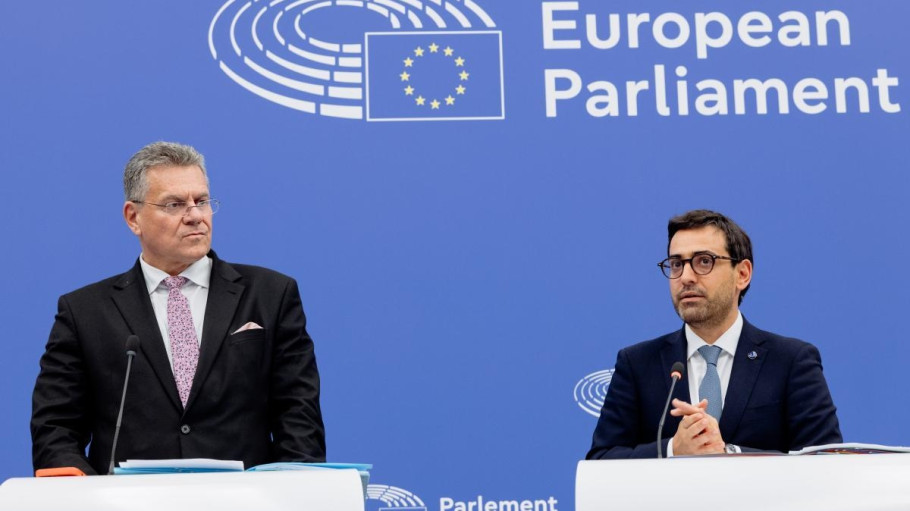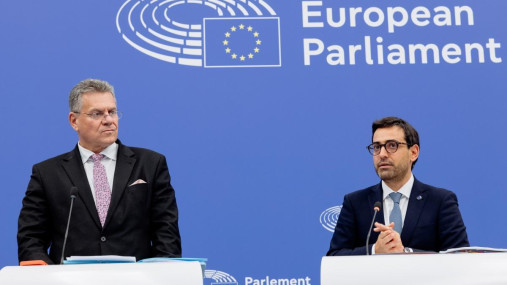
Press releases » New trade measure is major leap forward to save EU steel and hundreds of thousands of jobs; now fast-track adoption is crucial, says EUROFER
New trade measure is major leap forward to save EU steel and hundreds of thousands of jobs; now fast-track adoption is crucial, says EUROFER
Downloads and links
Recent updates

Strasbourg, 07 October 2025 – The new trade measure presented today by the European Commission is a long-awaited proposal to forcefully defend the European steel sector, in full respect of WTO rules, from unfair imports flooding the EU market due to massive global overcapacity. The provisions unveiled by the Commission respond to the needs of the sector and represent a real lifeline for EU steelmakers and steelworkers. The European Parliament and the Council should therefore adopt it as a matter of urgency to enable its entry into force at the beginning of 2026, says the European Steel Association (EUROFER).
“We strongly welcome and fully support the Commission’s proposal on the new steel trade measure. This is a major leap forward to defend the sector and constitutes clear evidence that the Strategic Dialogue on Steel, initiated by President von der Leyen, is starting to bear fruit. We are thankful for the groundbreaking work carried out by EVP Séjourné and Commissioner Šefčovič to implement the most urgent point of the Steel and Metals Action Plan. This trade measure is vital to preserve not just the sector and its workforce, but the very backbone of EU industrial independence and green transition”, said Axel Eggert, Director General of EUROFER.
Unlike U.S. tariffs that impose 50% duties on all steel imports and are justified on unilateral national security grounds under U.S. Section 232, the new EU trade measure is fully WTO-compliant and based on Article 28 of the General Agreement on Tariffs and Trade (GATT). The EU measure introduces a Tariff Rate Quota (TRQ) system, allowing a fair volume of imports to enter Europe free of tariffs. This quota is set in line with 2013 market conditions before the first wave of Chinese steel flooding, at over 18 million tonnes of tariff-free steel – an amount almost equivalent to the combined steel production of France, Belgium, and Luxembourg. Only unsustainable imports above quota levels will be subject to a 50% tariff to avoid further import deflection towards the EU, with regular revisions to ensure quotas remain aligned with market conditions in the coming years. Steel derivatives – similarly under threat from cheap imports and also hit by U.S. tariffs - may be shielded in the future.
“The ultimate objective of reducing unfair imports flooding the EU market is to allow our steel plants to operate again at a viable utilisation rate of 80-85%. Currently, our facilities run at unsustainable utilisation levels of around 65%, provoking closures and layoffs – with the latest job cuts just announced in Finland – while one third of European steel demand is supplied by below-cost, high-carbon intensity imports. The measure also provides some of the visibility companies need to pursue their decarbonisation investments”, explained Mr Eggert.
“The Commission has crafted this new tool to ensure unhindered steel supply to Europe without significant impact on consumers. Steel derivatives and the jobs they support also require urgent support. The possibility of extending the new trade measure to these products demonstrates its potential to serve as a blueprint for safeguarding Europe’s wider industrial value chains. In parallel, the Commission will also engage with all relevant EU trading partners, in line with WTO principles”, he added.
The new trade measure also includes a ‘melted and poured’ (M&P) clause to trace the country of origin of steel, avoiding circumvention and more robustly ringfencing against the spillover effects of global overcapacity.
“We are hopeful that these new provisions will lay the ground for a renewed dialogue with the Trump administration to lift the current 50% tariffs on EU steel imports and relaunch work on an alliance to ringfence against global overcapacity. It is now essential that the European Parliament and Council swiftly adopt the Commission’s excellent proposal without delay, so that it can be in place by beginning of 2026. The fact that current safeguard quota levels have already been exceeded by triple digits in just two days is a deeply worrying signal of how critical the situation has become. As underlined at last week’s Emergency Steel Summit with our social partner industriAll, establishing all the conditions for a successful decarbonisation requires the new trade measure to be followed by an equally ambitious implementation of the other pillars of the Steel and Metals Action Plan – including action on energy prices, lead markets for European green content, the Carbon Border Adjustment Mechanism (CBAM), scrap exports and quality jobs”, concluded Mr Eggert.
Photo source: EC - Audiovisual Services, © European Union, 2025
Contact
Lucia Sali, Spokesperson and Head of Communications, +32 2 738 79 35, (l.sali@eurofer.eu)
About the European Steel Association (EUROFER)
EUROFER AISBL is located in Brussels and was founded in 1976. It represents the entirety of steel production in the European Union. EUROFER members are steel companies and national steel federations throughout the EU. The major steel companies and national steel federation of Turkey, Ukraine and the United Kingdom are associate members.
The European Steel Association is recorded in the EU transparency register: 93038071152-83.
About the European steel industry
The European steel industry is a world leader in innovation and environmental sustainability. It has a turnover of around €215 billion and directly employs around 298,000 highly-skilled people, producing on average 146 million tonnes of steel per year. More than 500 steel production sites across 22 EU Member States provide direct and indirect employment to millions more European citizens. Closely integrated with Europe’s manufacturing and construction industries, steel is the backbone for development, growth and employment in Europe.
Steel is the most versatile industrial material in the world. The thousands of different grades and types of steel developed by the industry make the modern world possible. Steel is 100% recyclable and therefore is a fundamental part of the circular economy. As a basic engineering material, steel is also an essential factor in the development and deployment of innovative, CO2-mitigating technologies, improving resource efficiency and fostering sustainable development in Europe.

A milestone occasion to quickly and effectively restore affordable electricity, to relaunch the
decarbonization and strengthen the international competitiveness of the European steel
industry.
Brussels, 02 December 2025 – Unchanged negative conditions – U.S. tariffs and trade disruptions, economic and geopolitical tensions, protracted weak demand and still high energy prices – continue to weigh on the European steel market. EUROFER’s latest Economic and Steel Market Outlook confirms for 2025 another recession in both apparent steel consumption (-0.2%, unchanged) and steel-using sectors (-0.5%, revised from -0.7%). A potential recovery is expected only in 2026 for the Steel Weighted Industrial Production index (SWIP) (+1.8%, stable) and for apparent steel consumption (+3%, slightly revised from +3.1%) – although consumption volumes would still remain well below pre-pandemic levels. Steel imports retained historically high shares (27%), while exports plummeted (-9%) in the first eight months of 2025.
Fourth quarter 2025 report. Data up to, and including, second quarter 2025